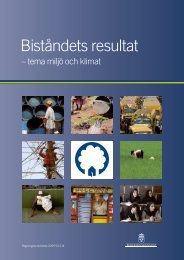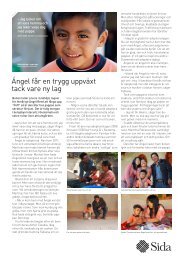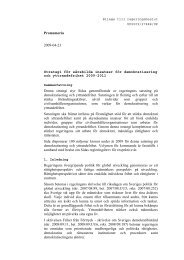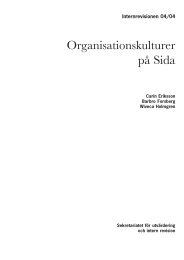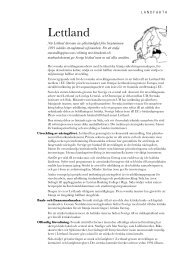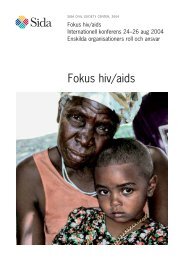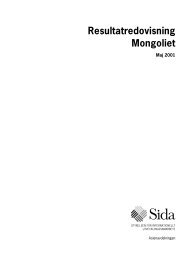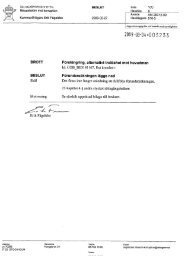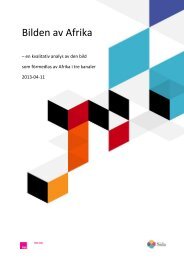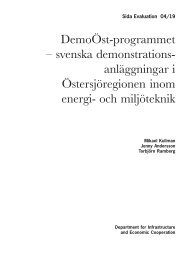Mid-Term Review of the AGIR Programme - Sida
Mid-Term Review of the AGIR Programme - Sida
Mid-Term Review of the AGIR Programme - Sida
You also want an ePaper? Increase the reach of your titles
YUMPU automatically turns print PDFs into web optimized ePapers that Google loves.
2 F I N D I N G S<br />
iii) Key Partners have 40% women in staff and in <strong>the</strong> leader ship<br />
Joint Outcome 5.2.3: Due to knowledge acquired in gender and HIV/AIDS<br />
during <strong>the</strong> support to partnerships, partners are effective in <strong>the</strong>ir work. To be<br />
achieved by <strong>the</strong> following indicators:<br />
i) Contextual analysis by key partners takes in consideration gender and<br />
HIV/AIDS issues. 30<br />
ii) Programmatic choices <strong>of</strong> key partners show sensitivity in relation to<br />
gender.<br />
iii) Programmatic choices <strong>of</strong> key partners show sensitivity in relation to<br />
HIV/AIDS.<br />
However, in o<strong>the</strong>r intermediary 2012 annual plan documents 31 <strong>the</strong>se specific joint<br />
indicators are only partially referred to, or only <strong>the</strong> joint outcome is referred to, or <strong>the</strong><br />
expectations are reduced and indicators simplified.<br />
In <strong>the</strong>se simplified versions <strong>the</strong> expected implementation indicator/target is:<br />
Outcome 5.1.4:<br />
i) At least 80% <strong>of</strong> supported key actors have WPP (Work Plan Policy) on<br />
HIV/AIDS in place.<br />
ii) 40% women in staff and in <strong>the</strong> leadership<br />
Outcome 5.2.3:<br />
i) Partner analysis (30%) takes into account gender and HIV as part <strong>of</strong> context.<br />
ii) Gender and HIV context analysis is reflected in 30% <strong>of</strong> key actors’ programmes.<br />
The simplified version appears more realistic considering <strong>the</strong> number <strong>of</strong> new partners<br />
<strong>AGIR</strong> has recently taken on. With some <strong>of</strong> <strong>the</strong>se new partner organisations being at<br />
<strong>the</strong> local level, <strong>the</strong>se local-level partners represent a fur<strong>the</strong>r challenge to a process <strong>of</strong><br />
centralised capacity streng<strong>the</strong>ning in crosscutting <strong>the</strong>mes. With this in mind it becomes<br />
clear that to attain even <strong>the</strong> simplified version <strong>of</strong> <strong>the</strong> outcomes, <strong>the</strong>re will need<br />
to be an intensified joint effort required by <strong>the</strong> intermediaries in gender and<br />
HIV/AIDS capacity streng<strong>the</strong>ning for CSO partners.<br />
Human Rights<br />
CSOs tend to consider <strong>the</strong>ir areas <strong>of</strong> specialisation as implicitly dealing with human<br />
rights, which makes fur<strong>the</strong>r explanation unnecessary. For example, LDH considers<br />
human rights to encompass everything it does. For Forum Mulher, defending human<br />
rights is part <strong>of</strong> human rights promotion; for <strong>the</strong> Electoral Observatory, improving<br />
30 The numbering (reference) <strong>of</strong> outcomes in <strong>the</strong> joint outcome matrix differs from one document to<br />
ano<strong>the</strong>r.<br />
31 For example, Ibis and SCC annual plans.<br />
64




